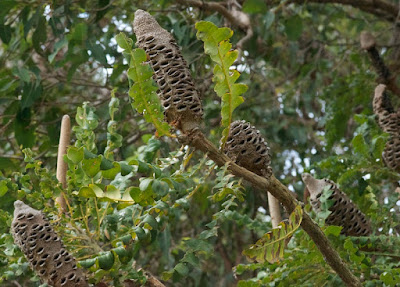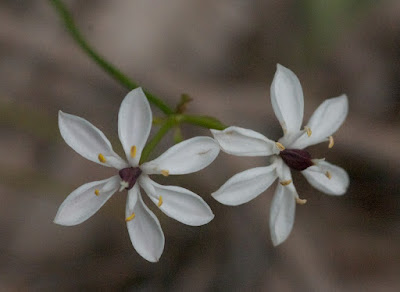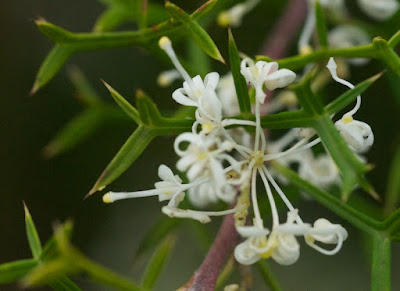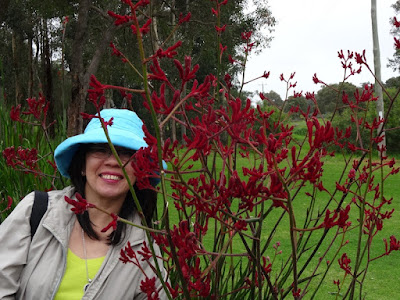There's certainly more to the area than wine. About two-thirds of the way down the peninsula is the Lake Cave Mammoth Cave Nature Reserve, where the Karri trees (Eucalyptus diversicolor) reach some 60 metres in height despite the fact that the area was logged a century ago.
A couple of our companions couldn't see why these immense trees were more interesting than the far smaller ones we had seen on the way here. Well, nature doesn't impress everyone, more's the pity.
Beneath the karri we found Bull Banksia (Banksia grandis), a common species, confined to the far southwest,with the largest flower spikes of any of the banksias. The old spikes from the previous season are still impressive; they can be up to 40 cm long. New flowers would have appeared after our visit, in October.
Tree Hovea (Hovea elliptica), another specialty of the humid southwestern forests, is a flowering pea that we had seen on our first trip into the karri, almost two weeks (and many blog entries) earlier.
Cutleaf Hibbertia (Hibbertia cuneiformis), one of the tallest of the so-called native buttercups (though a member of the Dilleniaceae, not the Ranunculaceae to which the 'true' buttercups belong) provided another spot of colour in the undergrowth; it, too, is a humid-belt speacialist, confined to areas near the coast, and common beneath the karri trees.
I would have liked to spend longer among the karri trees, especially because of the tantalizing cries I could hear coming from the top of a nearby slope south of the entrance to Giant's Cave. They were the calls of the rarer of Western Australia's two endemic black cockatoos, the Baudin's or Long-billed Black Cockatoo (Calyptorhynchus baudinii), an Endangered species pretty much confined to the humid eucalyptus forest of the far southwest where it uses its long, hooked upper mandible to break into eucalyptus fruits. I glimpsed the birds, too, but just for a moment as they flew through the canopy.
We were, however, bound further north, to the wineries that lay between us and Cape Naturaliste (barring the occasional roadside flower stop). This one lay south and west of the little town of Metricup.
While our companions checked out the vintages, I focused on the wildflowers growing along the road. They included Common Hovea (Hovea trisperma), a cousin of the Tree Hovea of the karri forests.
Coral Vine (Kennedia coccinea) is a pea of a different colour: a ground-hugging, clambering vine.
This flower is, I am almost certain, a species of Dampiera (Goodeniaceae), but (as has been so often the case in these entries) I am not sure which one.
I'm not sure about the species of this one either, though it is certainly one of the Milkmaids (Burchardia sp).,
I like the way the delicate white flowers of the widespread Honey Bush (Hakea lissocarpha) contrast with its fearsome-looking, spiky leaves.
Onion Grass (Romulea rosea) is an alien weed in Australia, but a delicate and attractive one. I photographed it in a number of areas without, I admit, having the faintest idea what it was.
From the winery we drove a short distance to the grounds of the Margaret River Chocolate Company (which was at least selling a commodity I could appreciate). These Red Kangaroo Paws (Anigozanthos rufus) were growing in a planted flower bed by the store entrance; the natural range of this species is further east, from Albany eastward to Esperance along the southern coast.
Their flowers were popular with Red Wattlebirds (Anthochaera carunculata), among the larger and more aggressive of the honeyeaters.
Their nectar proved an irresistable lure for the birds, who paid not the slightest attention to me (as I had broken my telephoto lens the day before, I had only a 110 mm macro lens to work with - so you can see that I could not have been very far from my subjects). The 'red' of the Red Wattlebird, by the way, is confined to the fleshy wattle below its ear.
A few other birds in the area were tame enough to let me get a photo, though I admit this shot of a pair of Yellow-rumped Thornbills (Acanthiza chrysorrhoa) is hardly ideal.
I gad better luck with a stunning male Red-winged Fairy Wren (Malurus elegans) - admittedly, with the help of a tape. These are highly aggressive little birds.
I am particularly partial to fairy-wrens; mind you, I can't imagine a birder who wouldn't be. This one, though it is elfin enough, is the largest of the Australian species (there are a few larger ones in New Guinea). It is entirely confined to the humid zone in the southwestern corner of the continent. Unlike its very similar dry-country cousin the Blue-breasted Fairy-Wren (Malurus pulcherrimus), this is a highly polygamous species, usually living in family groups of up to nine birds.
Our wine (and chocolate) tasting done, we tried to drive up to Cape Naturaliste for the view. Unfortunately, you can't get to see the view unless you pay an exorbitant sum to visit the lighthouse (visible in the distance above), so we got no closer than a tangle of coastal heath.
We had better luck a short distance down the road at Eagle Bay, where for no charge we could stroll down to the boulder-strewn beach and have a look at the sea.
I scanned the horizon - this is a famous seabird spot - and was rewarded by a very distant view of what was possibly an Indian Yellow-nosed Albatross (Thalassarche carteri), a highly likely species here. Anyway, it was an albatross, and as always I found myself in awe (even at a distance) of this great bird as it wheeled away, on stiff wings, over the calm waters of the Indian Ocean.


































No comments:
Post a Comment